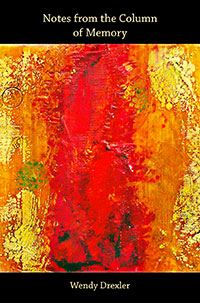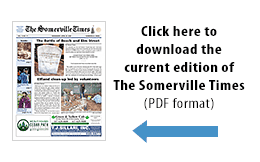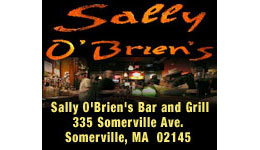 *
*
I caught up with poet Wendy Drexler recently. An accomplished poet, Drexler is a fellow board member of the New England Poetry Club, and a very active part of the literary community.
Drexler is the recipient of a 2022 artist fellowship from the Massachusetts Cultural Council. She is the author of two earlier collections, most recently Before There Was Before (Iris Press, 2017). Her poems have appeared in Barrow Street, Nimrod, Prairie Schooner, The Threepenny Review, and Valparaiso Poetry Review, among others. Her work has been featured on Verse Daily and WBUR, and in numerous anthologies. She has been the Poet-in-Residence at New Mission High School in Hyde Park, Massachusetts, since 2018, and is programming co-chair for the New England Poetry Club. She lives in Belmont, Massachusetts.
Doug Holder: You have a new poetry collection out, Notes from the Column of Memory. What was the germ of idea for the collection?
Wendy Drexler: The germ of the idea was an ekphrastic poem that I wrote last summer for Art on the Trails as a call for poems in response to sculptures installed at the Beals Preserve in Southborough, MA. My poem received the Juror’s Prize and I was invited to be the judge this year. My winning poem was inspired by a sculpture titled Notes from the Column of Memory by Donna Conklin King. Written in the shape of a column, it begins “See how time breaks us / and still we stand . . .” My manuscript had gone through many versions but seemed to lack an overriding theme. I realized that I could reorganize my manuscript around this poem and the hinge of memory.
DH: You have a number of poems about your late biological father. In one you deftly compare him to a fox. Why did you use this conceit, rather than to approach him straight on as a man you were estranged from?
WD: My Father as a Taxidermied Fox began as a poem about trying to draw a taxidermied fox in a class I took at the Peabody Museum of Natural History in Cambridge. I chose to draw a fox because I love foxes and have seen them on the Cape. In fact, one actually did stroll into the Fine Arts Work Center in Provincetown, as I mention in my poem, and sniffed a cup of coffee left on the floor after a poetry reading. As hard as it is to try to draw an animal, it is also difficult to recapture the essence of a loved one, especially a parent, who has died. As I say in the poem I’ve failed to flush an ounce of you from death. But that’s the poet’s job: to try! I was always very close to my father, not estranged, but he’d told me a secret that I refer to in the previous poem, and the keeping of that secret was a burden and reflected a mysterious side of him that I was, for better or worse, only partially privy to. My mother also features prominently in this collection in a crown of sonnets that explores our relationship.
DH: In the poem Bluebird you celebrate the blue beauty of the bird. I love the last line where you address the bird as, “carrying the sky on your back.” So, on one level it is the sky blue on the back of the bird. But you use an Emily Dickinson quote earlier in the book about a bird being the quickest route to heaven. Do you believe birds have a strong spiritual essence to them. Are they messengers of some sort?
WD: Yes, I love that line, too, which I stole from Thoreau! I find birds to be very spiritual and can lose myself watching them. Of course, they are beautiful too, and endowed with the gift of song and of flight. It can be tempting to anthropomorphize them, however, which I try not to do. Though I kinda do in this poem! I see them more as inspiration and solace rather than as messengers. And when I’m troubled or anxious, going out and to look for and try to identify birds pares time down to the moment and helps me live more fully in the present.
DH: Your poems are steeped in nature. I noticed you have referred to any number of artists – Cezanne, Monet, Hooper – in the book. So not only nature inspires you, but visual artists’ interpretations of nature come into play.
WD: Yes, I’m inspired by art and enjoy responding to images that move me. I majored in art history in college, and my mother was a painter. I grew up surrounded by art and have taken drawing, watercolor, and pastel classes. I enjoy beginning a poem by describing what I see in an image and letting that lead me into deeper territory. Mark Doty does this so well, I think.
DH: How has your stint as poet-in-residence at the New Mission High School in Hyde Park and your programming co-chair at the New England Poetry Club helped or hindered your writing?
WD: Each of these activities connects me in different ways to poetry and to our poetic community. It’s been a joy to participate on the board of the New England Poetry Club (now with you, Doug!), a chance to help promote local poets and to bring more diversity to our reading series, to get to know our wonderful board members and problem solve and plan together, and to have the great joy of hanging out with our inspiring poets and Golden Rose winners. This year, Patricia Smith was the recipient of the Golden Rose and we honored her with dinner at The Little Crepe Cafe in Somerville, which was a delight.
As the poet in residence co-teaching a Creative Writing elective at New Mission, which I’ve done for the last four years (the last two on Zoom, which has been challenging), I’ve grown in confidence as a teacher and realize I love teaching! I also have enjoyed a wonderful partnership co-teaching and collaborating with Myles McNamara, a gifted New Mission English teacher. Teaching has challenged me to really own and articulate what I know about poetry: the importance of unpremeditated free writes, the empowerment of each student’s voice, and the importance of learning craft (imagery, sound devices, line breaks, form, the turn, metaphor, simile, etc.), and of the importance of not knowing where you are going and discovering an insight along the way. Reading my students’ poems can also be deeply gratifying, and often brings tears when I read their work, how brave and open they can be, how much they have to share. They teach me. Through the graces of Mass Poetry, we’ve also done some spoken word with Crystal Valentine and I was inspired hearing them perform in the auditorium and on the stage at Mass Poetry’s new headquarters in the Seaport. I see I’ve written a lot here! Clearly both these activities have helped my writing!
DH: Why should we read your book?
WD: To answer that, I’d like to refer you to the wonderful blurbs that Martha Collins, Regie Gibson, and Donika Kelly have written for the book. I think my book speaks to anyone interested in exploring and excavating the past and in observing the present and the intersections between past and present, anyone who wants to engage with, and remain alive to, astonishment in a world that often breaks your heart over and over with the terrible, the beautiful, the uncertain, and the diminished. To quote Anne Carson, whose epigraph I use at the beginning of my book, “It is when you are asking about something that you realize you have survived it, and so you must carry it, or fashion it into a thing that carries itself.” I hope that those who read my book are moved by that carrying, that fashioning, and in turn will discover and feel compassion toward what they have carried and continue to carry, and to their own aliveness.
Please explore my website, wendydrexlerpoetry.com and those interested in purchasing my book can find it at Belmont Books, Porter Square Books, and Brookline Booksmith. Purchasing links can be found on my website.















Hello, thank you for the mention! I would just like to point out that my sculpture mentioned in this article is actually titled “Column of Healing”. It is made with concrete and has a mirror glass spiral on the top surface that reflects the sky.
It is currently on exhibit at the DuCret School of Art in Plainfield, NJ in an exhibition titled “Evanescent”. Thank you!
Thank god for Google alerts!